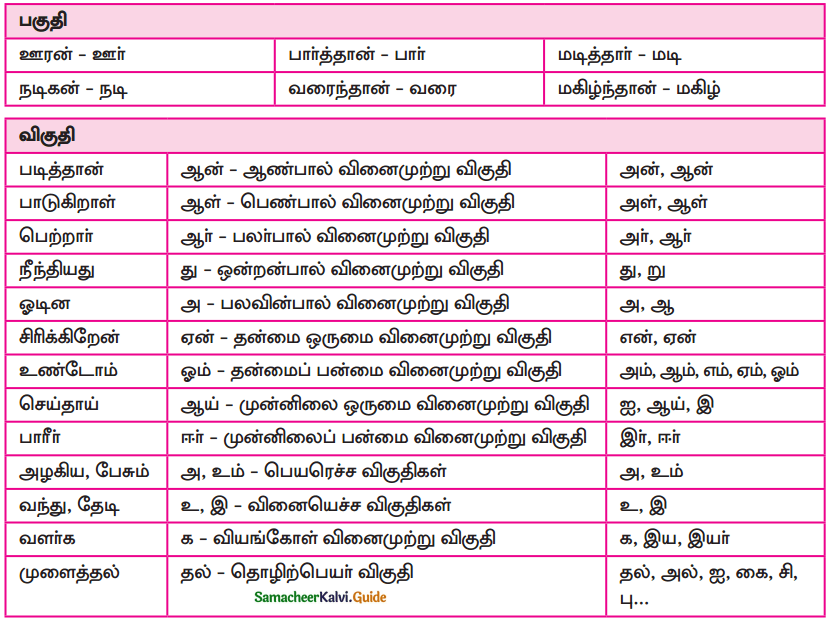Students can Download 9th Tamil Chapter 2.3 பெரியபுராணம் Questions and Answers, Summary, Notes, Samacheer Kalvi 9th Tamil Guide Pdf helps you to revise the complete Tamilnadu State Board New Syllabus, helps students complete homework assignments and to score high marks in board exams.
Tamilnadu Samacheer Kalvi 9th Tamil Solutions Chapter 2.3 பெரியபுராணம்
கற்பவை கற்றபின்
Question 1.
மூச்சு விடும் மரம், புரட்டிப் போட்ட புயல், இசை பாடும் பறவைகள், பனித்துளியில் தெரியும் பனை, என் இனிய கனவு போன்ற தலைப்புகளில் பள்ளி இலக்கிய மன்றத்தில் கவிதை படிக்க.
Answer:

![]()
Question 2.
கவிதையின் விவரிப்பை உரைநடையில் எழுதுக.
Answer:
வானகமே, இளவெயிலே, மரச்செறிவே, நீங்களெல்லாம்
கானலின் நீரோ? – வெறுங்காட்சிப் பிழைதானோ?
போன தெல்லாம் கனவினைப்போல் புதைந்தழிந்தே
போனதனால் நானும் ஓர் கனவோ? – இந்த
ஞாலமும் பொய்தானோ? – பாரதியார்
பாடல் கருத்து:
வானகமே, வானில் தோன்றும் சூரியன் வெளிப்படுத்தும் இளவெளிலே, மரக்கூட்டங்களே, நீங்கள் கானல் நீர் அல்ல ……. கடவுளின் படைப்புகள். நீங்கள் வெறும் காட்சிப் பிழைகள் இல்லை . உண்மை வடிவம். ஆனால் வாழ்வின் கனவுகள் கனவைப் போலவே …… அழிந்து போனதால் நானும் அழிந்துபோகும் கனவா ……. இந்த நிலவுலகமும் பொய்யாகுமோ?
பாடநூல் வினாக்கள்
குறுவினா
Question 1.
நிலையான வானத்தில் தோன்றி மறையும் காட்சிக்குப் பெரியபுராணம் எதனை ஒப்பிடுகிறது?
Answer:
பெரிய புராணத்தில் அழகாக திருநாட்டின் சிறப்பு வருணிக்கப்படுகிறது. அந்நாட்டின் நீர் நிலைகள் அன்னங்கள் விளையாடும் அகலமான படித்துறைகளைக் கொண்டன. அதில் எருமைகள் வீழ்ந்து முழ்கும். அதனால் நீர் நிலைகளிலுள்ள வாளைமீன்கள் துள்ளி எழுந்து அருகில் உள்ள பாக்குமரங்களின் மீது பாயும். இக்காட்சியானது வானத்தில் தோன்றி மறையும் வானவில்லைப் போன்று விளங்கும்.
![]()
நெடுவினா
Question 1.
பெரியபுராணம் காட்டும் திருநாட்டுச் சிறப்பினைத் தொகுத்து எழுதுக.
Answer:
முன்னுரை :
சைவ சமயப் பெரியவர்களான சுந்தரரும் நம்பியாண்டார் நம்பியும் பாடிய சைவ அடியார்களின் வரலாற்றுக் குறிப்புகளின் விரிவான நூலே பெரிய புராணம் ஆகும். இதைப் பாடியவர் சேக்கிழார். ஒவ்வொரு புராணத்திலும் ஒவ்வோர் அடியவராக அறுபத்து மூவர் சிறப்புகளைப் பாடியிருக்கிறார் “பக்திச்சுவை நுனி சொட்டச் சொட்டப் பாடிய கவிவலவ” என்று இவரை மகாவித்வான் மீனாட்சி சுந்தரம் பிள்ளை பாராட்டுவார். திருநாட்டுச் சிறப்பை இயற்கை வளத்துடன் விளக்கியிருக்கிறார் சேக்கிழார். அதை உற்று நோக்குவோம்.
காவிரிக் கால்வாய்கள் :
காவிரி நீர் மலையிலிருந்து தேன் நிரம்பிய பூக்களை அடித்துக்கொண்டு வருகிறது. அதை வண்டுகள் சூழ்ந்து ஆரவாரம் செய்கின்றன. நீர்நிலைகள் நிறைந்த நாட்டுக்கு வளம் தரும் பொருட்டுக் காவிரிநீர் கால்வாய்களில் எங்கும் பரந்து ஓடுகிறது.
![]()
உழத்தியரின் கால்களை இடறும் சங்குகள் :
நாற்றுகள் செழித்து வளர்ந்து செடிகள் ஆயின. முதல் இலை சுருள் விழுந்ததால் களை பறிக்கும் பருவம் வந்தது. களைகளைந்து செல்லும் உழத்தியர்களின் நூல்களில் முத்துக்களை ஈனும் சங்குகள் இடறின. அதனால் இடைதளர்ந்து வண்டுகள் மொய்க்கும் மலர்களையுடைய கூந்தல் அசையுமாறு வரப்பினைச் சென்று அடைந்தனர்.
சோழநாட்டுச் சிறப்பு :
காடுகளில் கரும்புகளும் சோலைகள் எங்கும் மலர் அரும்புகளும் உள்ளன. வயலின் ஓரங்களில் கரியகுவளை மலர்கள் மலர்ந்துள்ளன. வயல்களில் சங்குகள் கிடக்கின்றன. நீர்நிலைகளில் அன்னங்கள் உலவுகின்றன. குளங்கள் நிறைந்து கடலைப் போல் காட்சியளிக்கின்றன. நாடு முழுவதும் நீர் நாடு என்று சொல்லத்தக்க அளவில் வளமுடையது திருநாடு.
![]()
வாளை மீனும் வானவில்லும் :
அன்னங்கள் நீந்தி விளையாடும் நீர்நிலைகளில் எருமைகள் விழுந்து மூழ்கின. அதனால் அங்குள்ள வாளை மீன்கள் துள்ளி எழுந்து அருகிலுள்ள பாக்கு மரங்களின் மீது தாவிப் பாயும். இக்காட்சி வானத்தில் தோன்றி மறையும் வானவில்லைப் போன்றதாகும். அரிந்த செந்நெல்லின் சூடுகளைப் (நெற்கற்றை) பெரிய போராகக் குவிப்பர். பிடித்த மீன்களையும் குன்றைப் போல் குவித்து வைப்பர். பக்கத்திலேயே தேன் வழியும் மலர்த் தொகுதியை மலைபோல் குவித்து வைப்பர்.
மேகங்கள் தவழும் பொன்மலை :
மேலேயிருந்து நெற்கற்றைகளைச் சாயச் செய்து எருமைகள் பூட்டப்பட்ட வண்டிகளில் ஏற்றுவர் வலமாக சுற்றிச் சுற்றி மிதக்கும் இத்தோற்றமானது கரிய மேகங்கள் பொன்மலையின் மீது வலமாகச் சுற்றுகின்ற காட்சி போல் உள்ளது.
மரங்கள் அணிவகுப்பு:
நீர்வளம் நிரம்பிய அந்நாட்டின் தென்னை , செருந்தி, நரந்தம் ஒரு பக்கம், அரசமரம், கடம்பமரம், பச்சிலைமரம், குராமரம் வேறு ஒரு பக்கம், பெரிய அடிப்பாகம் உடைய பனை, சந்தனம், நாகம் வஞ்சி, காஞ்சி, கோங்கு முதலிய மரங்கள் அடர்ந்து செழிந்து வளர்ந்துள்ளன. நீர்வளமும், நிலவளமுடைய திருநாடு காவிரிநீர் பாய்வதால் இயற்கைச் சூழல் நிறைந்த நாடாக விளங்குகிறது.
![]()
கூடுதல் வினாக்கள்
பலவுள் தெரிக
Question 1.
பொருந்தாத இணையைத் தேர்ந்தெடு.
அ) மாணிக்கவாசகர் – திருவாசகம்
ஆ) திருமூலர் – திருமந்திரம்
இ) சுந்தரர் – தேவாரம்
ஈ) சேக்கிழார் – திருவிளையாடற்புராணம்
Answer:
ஈ) சேக்கிழார் – திருவிளையாடற்புராணம்
![]()
Question 2.
‘திருத்தொண்டர் திருவந்தாதி’ பாடியவர் …………
அ) அபிராமி பட்டர்
ஆ) சுந்தரர்
இ) நம்பியாண்டார் நம்பி
ஈ) சேக்கிழார்
Answer:
இ) நம்பியாண்டார் நம்பி
Question 3.
பொருந்தாாத இணையைத் தேர்ந்தெடுக்க.
அ) தரளம் – முத்து
ஆ) பணிலம் – சங்கு
இ) வேரி – தேன்
ஈ) சந்து – நெல்
Answer:
ஈ) சந்து – நெல்
Question 4.
பொருத்துக
1. நாளிகேரம் – i) அரச மரம்
2. கோளி – ii) நெல் அரிக்கட்டு
3. சூடு – iii) தென்னை
4. கழை – iv) கரும்பு
அ) 1. ii 2. iv 3. i 4. iii
ஆ) 1. iii 2. iv 3. i 4. ii
இ) 1. iii 2. i 3. ii 4. iv
ஈ) 1. iv 2. iii 3.j 4. ii
Answer:
இ) 1. iii 2. i 3. ii 4. iv
![]()
Question 5.
வரிசைப்படுத்துக.
1. காவிரி நீர் கால்வாய்களில் பரந்து ஓடுகிறது.
2. காவிரி நீர் மலையிலிருந்து புதிய பூக்களை அடித்துக்கொண்டு வருகிறது.
3. வண்டுகள் சூழ்ந்து ஆரவாரம் செய்கின்றன.
4. பூக்களில் தேன் நிறைந்துள்ளது.
அ) 1, 2, 3, 4
ஆ) 4, 2, 1, 3
இ) 2, 1, 4, 3
ஈ) 2, 4, 3, 1
Answer:
ஈ) 2, 4, 3, 1
Question 6.
பொருந்தாத கவிஞரைத் தேர்ந்தெடு.
அ) ஆண்டாள்
ஆ) காரைக்காலம்மையார்
இ) திருஞானசம்பந்தர்
ஈ) சேக்கிழார்
Answer:
ஆ) காரைக்காலம்மையார்
![]()
7. பெரிய புராணத்தில் ‘திருநாடு’ எனக் குறிப்பிடப்படுவது ……
Answer:
சோழ நாடு
8. திருத்தொண்டத் தொகை பாடியவர் ..
Answer:
சுந்தரர்
9. திருத்தொண்டர் திருவந்தாதி இயற்றியவர் ………..
Answer:
நம்பியாண்டார் நம்பி
10. சேக்கிழார் வாழ்ந்த காலம் ………..
Answer:
கி.பி. 12ம் நூற்றாண்டு
11. ‘பக்திச்சுவை நனி சொட்டச்சொட்டப் பாடிய கவி வலவ’ என யார் யாரைப் போற்றியது?
Answer:
மீனாட்சி சுந்தரம்பிள்ளை, சேக்கிழாரை
![]()
12. மகாவித்வான் எனப் போற்றப்படுபவர் …………..
Answer:
மீனாட்சி சுந்தரம்பிள்ளை
13. பொருத்துக : சொல்

Answer:
1.ஆ 2.உ 3.அ 4.இ 5.ஊ 6.ஈ
14. நீர்நாடு எனப் போற்றப்படும் நாடு …….
Answer:
சோழநாடு
15. குலோத்துங்க சோழன் அவையில் தலைமை அமைச்சராக இருந்தவர் ………..
Answer:
சேக்கிழார்
![]()
16. சங்கு, முத்து – எனும் பொருள் தரும் சொற்கள் முறையே ……….
Answer:
பணிலம், தரளம்
குறுவினா
Question 1.
காவிரிக் கால்வாய்களின் சிறப்பாக பெரிய புராணம் கூறும் கருத்துகளைக் கூறுக.
asnwer:
காவிரி நீர் மலையிலிருந்து தேன் நிரம்பிய பூக்களை அடித்துக்கொண்டு வருகிறது. அதை வண்டுகள் சூழ்ந்து ஆரவாரம் செய்கின்றன. நீர்நிலைகள் நிறைந்த நாட்டுக்கு வளம் தரும்
பொருட்டுக் காவிரிநீர் கால்வாய்களில் எங்கும் பரந்து ஓடுகிறது.
![]()
Question 2.
சோழ நாட்டின் சிறப்புகளாக பெரிய புராணம் கூறுவன யாவை?
Answer:
காடுகளில் கரும்புகளும் சோலைகள் எங்கும் மலர் அரும்புகளும் உள்ளன. வயலின் ஓரங்களில் கரியகுவளை மலர்கள் மலர்ந்துள்ளன. வயல்களில் சங்குகள் கிடக்கின்றன. நீர்நிலைகளில் அன்னங்கள் உலவுகின்றன. குளங்கள் நிறைந்து கடலைப் போல் காட்சியளிக்கின்றன. நாடு முழுவதும் நீர் நாடு என்று சொல்லத்தக்க அளவில் வளமுடையது திருநாடு.








































